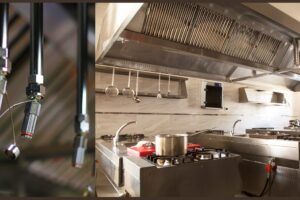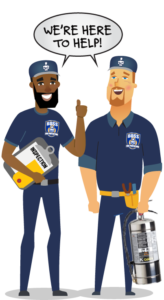A restaurant fire suppression system is a mandatory safety item in all restaurant kitchens, and for a very good reason. A fire can cause a catastrophic loss, causing everything you have worked so hard for to burn to the ground in minutes. Semi Annual inspections are essential in keeping your facility fire safe.
First knowing what type of and year the system was manufactured is essential to ensuring that it is up to safety standards and code. A new UL- 300 standard was developed by underwriters first and adopted by underwriters laboratories in 1992. This statute states that the fire suppression system is considered a (wet chemical) system, meaning that it will help prevent re-ignition of fire once the system has tripped. The semi-annual inspection on these new UL-300 systems is done by a certified technician to include examination and testing of the detection line, fuse links, cylinders, pull station, gas valve, piping and conduit of any signs of malfunction or code violations. There will also be a certification tag hung at the end of the inspection helping the local AHJ know the type of inspection completed.
A semi-annual inspection of a restaurant fire suppression system is crucial to ensure the system is in proper working condition and can effectively protect the establishment in case of a fire emergency. Here is a comprehensive list of items that are typically inspected, maintained, or replaced during such an inspection:
-
Visual Inspection: a. Examine the entire fire suppression system for any signs of damage, corrosion, or physical wear and tear. b. Check for obstructions, such as storage or equipment blocking access to nozzles and fire suppression equipment. c. Ensure all fire extinguisher units are in their designated locations and properly charged.
-
Manual Pull Station: a. Test the manual pull station to ensure it activates the fire suppression system when pulled.
-
Nozzles and Detectors: a. Inspect all nozzles and detectors for proper positioning and alignment. b. Clean nozzles to remove any buildup of grease or debris.
-
Control Panel: a. Verify that the control panel displays no errors or faults. b. Test the control panel to ensure it can activate and deactivate the fire suppression system.
-
Gas Cylinder(s): a. Check the pressure gauge on the gas cylinder(s) to ensure they are within the acceptable range. b. Weigh the gas cylinder(s) to ensure they contain the proper amount of fire suppression agent.
-
Fusible Links: a. Inspect fusible links to ensure they are intact and undamaged.
-
Electrical Wiring and Connections: a. Examine all electrical connections and wiring to ensure they are in good condition. b. Test the electrical shutdown of cooking equipment to verify it’s working correctly when the fire suppression system is activated.
-
Gas Shut-off Valve: a. Test the gas shut-off valve to ensure it closes when the fire suppression system is activated.
-
Discharge Nozzles: a. Verify that discharge nozzles are clear and unobstructed. b. Clean nozzles if needed.
-
Pressure Relief Vent: a. Inspect the pressure relief vent to ensure it is unblocked and functioning properly.
-
Hood and Ductwork: a. Inspect the restaurant’s hood and ductwork for grease buildup and ensure they are clean and in good condition.
-
Extinguishing Agent: a. Verify that there is an adequate supply of fire suppression agent in the system’s container. b. Ensure the agent is within the manufacturer’s specified temperature and pressure ranges.
-
Inspection Tag: a. Check the inspection tag to confirm the date of the last inspection and when the next inspection is due.
-
Documentation: a. Keep records of all inspection and maintenance activities for regulatory compliance and future reference.
-
Technician Training: a. Ensure that the technician conducting the inspection is properly trained and certified for fire suppression system maintenance.
-
Testing and Activation: a. Conduct a functional test of the fire suppression system, which may include a live test in a controlled environment to verify proper activation and agent discharge.
-
Compliance with Local Codes and Regulations: a. Ensure that the fire suppression system meets all local fire and building codes, and that any necessary permits are up to date.
Any necessary repairs, replacements, or adjustments identified during the semi-annual inspection should be promptly addressed to ensure the restaurant fire suppression system’s reliability and effectiveness. It is essential to work with a qualified fire suppression system service provider to perform these inspections and maintenance tasks.
If you need a semi-annual inspection or have any questions about the inspection process required by your Local Authority Having Jurisdiction, please give Boss Fire Protection a call at 972-704-1821.





